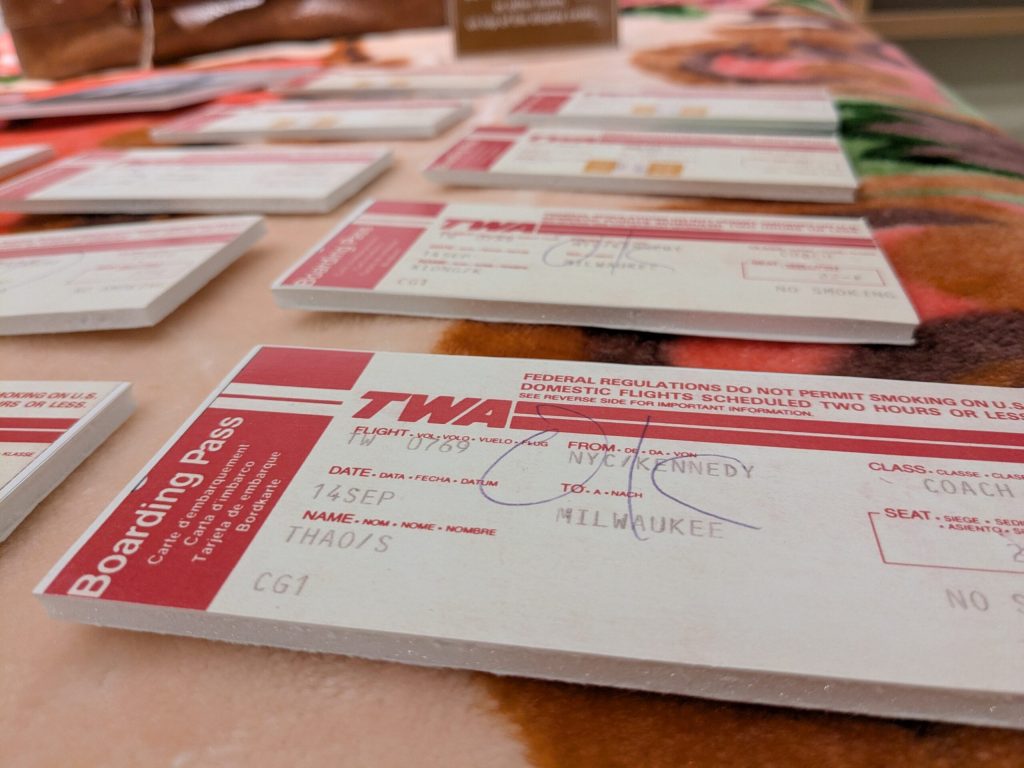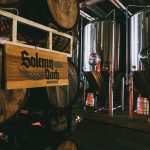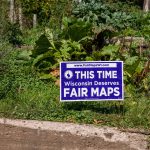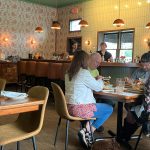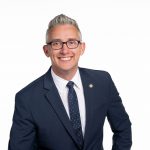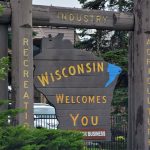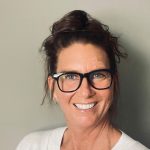Wisconsin Commemorates 50th Anniversary of Hmong Resettlement
Traveling exhibit at the Wisconsin Historical Society offers portrait of how Hmong people created community after fleeing war.
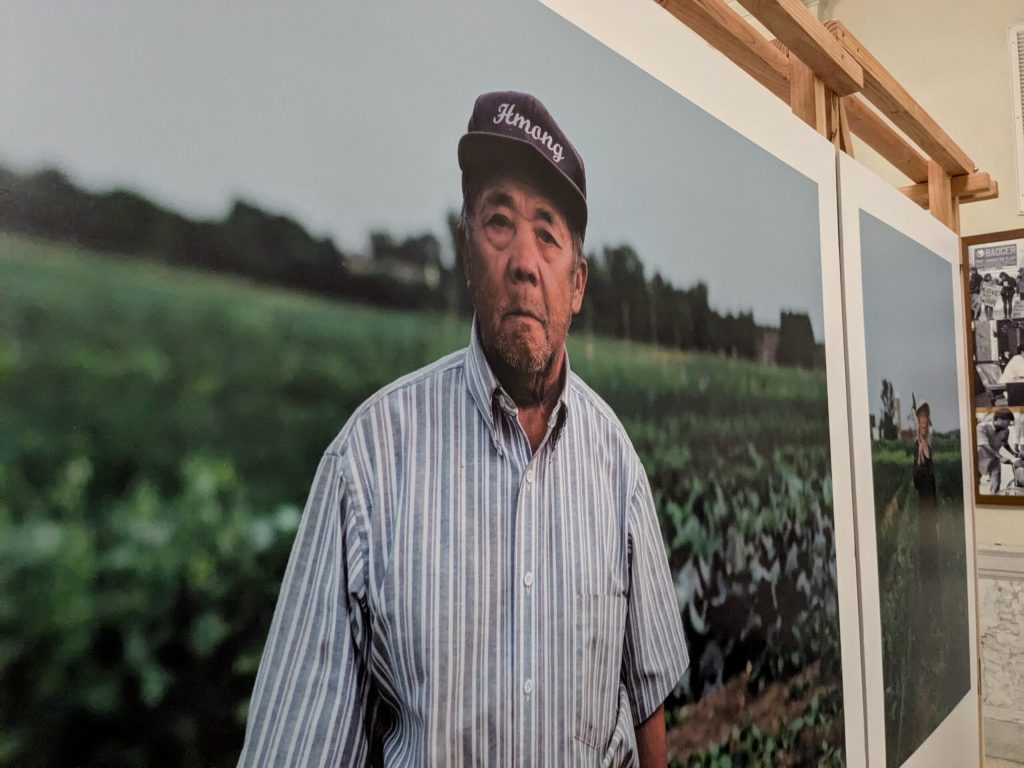
This photo taken by Milwaukee-based Hmong photographer May See Yang depicts her father. It is part of the garden area in the “Los Tsev, Cia Siab in Wisconsin” traveling exhibit, most recently on display at the Wisconsin Historical Society. Richelle Wilson/WPR
Fifty years ago, thousands of refugees came to states including Wisconsin after facing persecution for helping U.S. forces during the Secret War in Laos as part of the Vietnam War. Today, more than 60,000 Hmong people live in Wisconsin.
Southeast Asian community leaders gathered at the state Capitol on Wednesday to observe this anniversary and describe their own families’ journeys.
“Our families fled Laos and Thailand because of the American war in Southeast Asia,” Xiong added. “We came as Hmong and Southeast Asian refugees, uprooted from our homelands, resettled in a country whose language we did not speak into a new context we would have to learn to live and build community.”
Those leaders called for investments in Wisconsin’s Southeast Asian communities, including by celebrating the culture and contributions of the community and teaching their history.
“As I reflect on the many ways that I am Hmong, I realize that every new generation of Hmong has had to wrestle with what it means to be Hmong, and despite the challenges of extinction, we have endured,” said Brenda Yang, a Dane County Board supervisor.
“I hope that in the next 50 years, the Hmong community will continue to do the work of liberation, not just for ourselves, but for the sake of everyone, and to continue to be leaders in doing the hard work of cultural preservation, cultural identity and creating belonging,” Yang said.
Hmong veterans and the legacies of war
Since 2021, May 14 has been honored as Hmong-Lao Veterans Day in Wisconsin. A state law recognizes “Southeast Asians, Americans, and their allies who served, suffered, sacrificed, or died in the Secret War in Laos during the Vietnam War in the years 1961 to 1975 in support of the armed forces of the United States.” It calls for flags to fly at half-staff and encourages schools to discuss Hmong military service.
In the state Assembly on Tuesday, lawmakers approved a resolution commemorating the day and honoring Southeast Asian soldiers, and another “celebrating 50 years of strength and resilience of the Hmong, Lao, Cambodian, and Vietnamese people.”
Mai See Thao, a professor of anthropology at the University of Wisconsin-Madison, told WPR’s “Wisconsin Today” that these resolutions are “long overdue.”
“Recognizing Hmong-Lao veterans is really important because they have never received the kinds of recognition that they’ve needed, given the fact that they supported the U.S. as proxy soldiers,” she said.
Thao grew up in a small town in the Fox Valley after her family came to Wisconsin from a refugee camp in Thailand. She recalled a time in her high school history class when the teacher was giving a lesson about the Vietnam War.
“He told us that Americans fought in it, but there were other people in it, too. And he looked at me and he winked,” she said. “He didn’t say that Hmong people were a part of it, but he knew. And that, for me, has been a really interesting moment to think about the secrecy of the war and the omission of information from history.”
Thao said she has mixed feelings about Hmong American Day, also observed on May 14. She is happy to see her community receive greater visibility and recognition, but she also understands how this history can weigh heavily on Hmong people.
“For me, thinking about Hmong American Day is also a moment of mourning,” she said. “Hmong people are refugees that are a product of war. How do we recreate the world in a way that these conditions don’t have to create more refugees?”
Traveling exhibit showcases Hmong American lifeways
For nearly a decade, Thao has been one of the curators of a community-based traveling exhibit about Hmong people in Wisconsin called “Los Tsev, Cia Siab in Wisconsin,” meaning “Home, Hope.”
The evolving exhibit has been on display in Oshkosh, Eau Claire, Wausau and most recently at the Wisconsin Historical Society headquarters in Madison. The latest version looks back at the half-century of Hmong people making their home here in the state.
Kong Pheng Pha is a professor of gender and women’s studies and Asian American studies at UW-Madison, where his research focuses on refugee migration, especially of Hmong people. He co-curated the exhibit with Thao and other collaborators from across the state.
“We’re really honored, and we’re really proud of this work because it presents a different Hmong narrative — a narrative about war and healing, homemaking and life-making,” Pha told WPR.
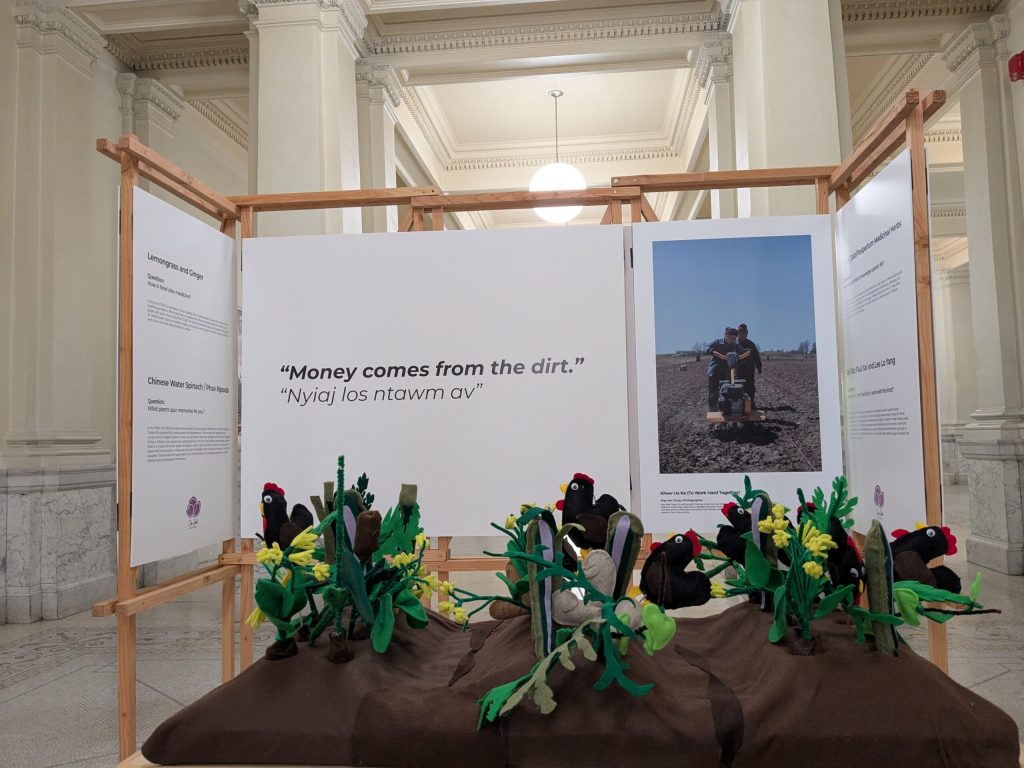
The garden area of the exhibit “Los Tsev, Cia Siab in Wisconsin” includes information about ginger and lemongrass and an interactive felt garden. Richelle Wilson/WPR
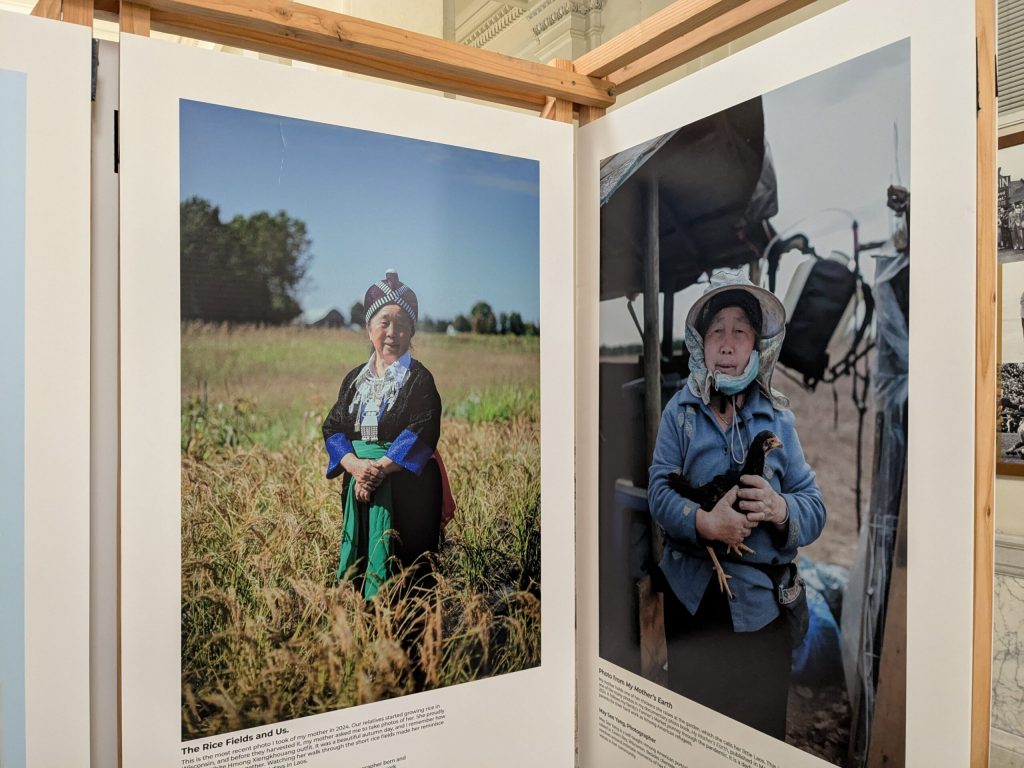
Enlarged copies of photos by Milwaukee-based Hmong photographer May See Yang appear throughout the exhibit. Richelle Wilson/WPR
The exhibit is set up like a home, with visitors moving through areas representing a kitchen, a living room, a bedroom, a garden. For Thao and Pha, it was important for the exhibit to center the lived experiences of Hmong people rather than the military history.
Near the front of the display is a garden area with information about ginger and lemongrass — vegetables important to Hmong cuisine — and images of Hmong farmers, including a portrait of Wisconsin-based Hmong photographer May See Yang’s father. An interactive craft garden made of felt has been popular with kids, according to historical society Public Programs Manager Jenny Pederson.
“We wanted to highlight young people whose voices are not part of this framework of military history but nonetheless are affected by these histories,” he said.
Moving into the interior, the kitchen display includes a video of one of Pha’s students documenting himself cooking and working through the different meanings of a kitchen knife: as a symbol of masculinity and violence but also home and cooking.
There’s also information about “eggroll fundraisers,” a popular way for Hmong communities around the state to raise money. Across the way, the living room includes a display of music by Hmong artists and a small bookshelf with information about Hmong literacy.
For Thao, the most personal area of the exhibit is the bedroom, where she shares her own family’s story of fleeing to the United States from a refugee camp in Thailand. Replicas of flight tickets, health manifests and even an X-ray taken of her father’s chest to confirm he didn’t have tuberculosis show just how difficult the journey was for Hmong refugees.
“These were so sacred [to my parents] because if they lost these documents, that would ultimately impact whether they could come to the U.S.,” Thao said.
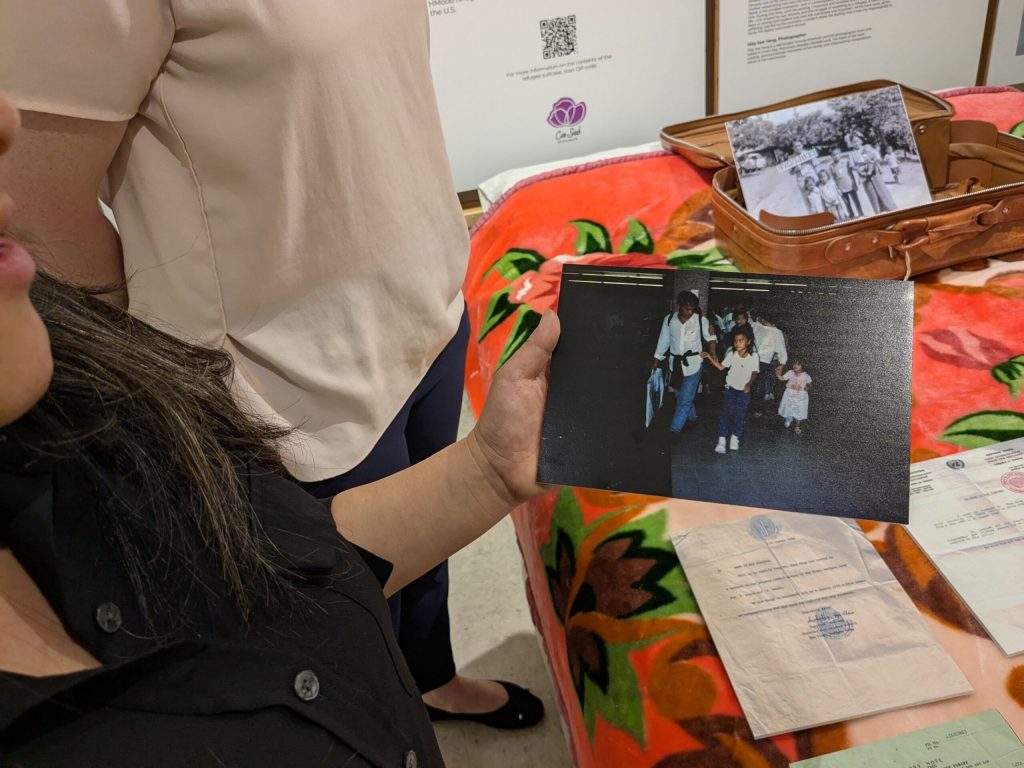
Mai See Thao shows a photo of her family arriving at the Milwaukee airport after their time at a refugee camp in Thailand. Richelle Wilson/WPR
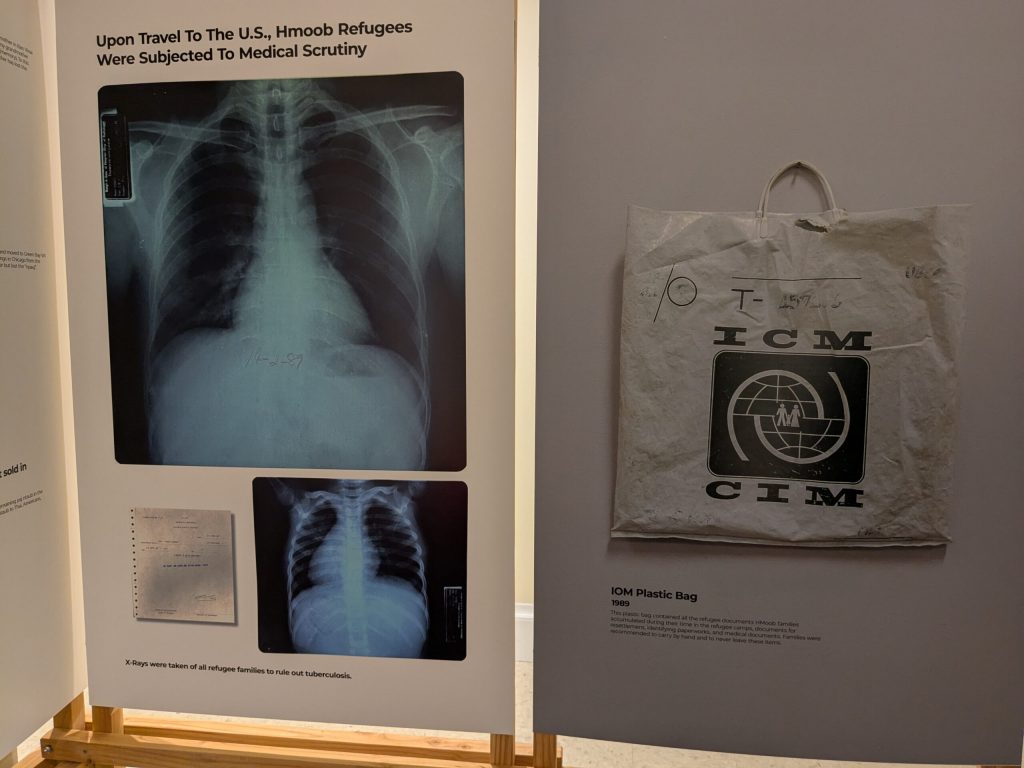
Mai See Thao said her father used to carry around this X-ray taken of his chest when entering the United States as a refugee in case he was ever stopped by immigration officials. Richelle Wilson/WPR
For the co-curators of “Los Tsev, Cia Siab,” the exhibit is in many ways personal, reflecting the lives and stories of their own families and communities. But for Thao, she also hopes it’s an opportunity for visitors to reflect on how history shows up in the present and “what it means to be human.”
The exhibit wrapped up its run at the Wisconsin Historical Society this week. It will next be on display from Sept. 11 to Oct. 2 in the Annex Gallery at the University of Wisconsin-Oshkosh, with a reception on opening day from 6 to 7:30 p.m.
WPR’s Anya van Wagtendonk contributed reporting to this story.
Wisconsin commemorates 50th anniversary of Hmong resettlement was originally published by Wisconsin Public Radio.
If you think stories like this are important, become a member of Urban Milwaukee and help support real, independent journalism. Plus you get some cool added benefits.


